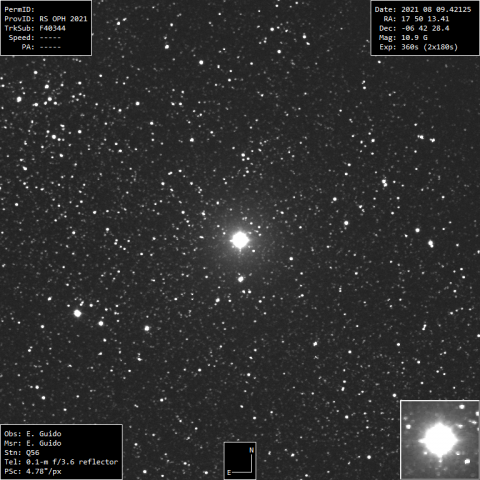› Forums › Variable Stars › Recurrent Nova RS Oph
- This topic has 43 replies, 15 voices, and was last updated 7 months, 2 weeks ago by
 Jeremy Shears.
Jeremy Shears.
-
AuthorPosts
-
9 August 2021 at 1:24 am #575025
 Gary PoynerParticipant
Gary PoynerParticipantThere are reports that the recurrent Nova (NR) RS Oph is in outburst on the evening of Aug 8 at mag 5, having been at magnitude 11.2 on Aug 7 (of course, it’s cloudy in Birmingham).
RS Oph last went into outburst in 2006. Observations of all types are urgently requested by the BAAVSS. BAAVSS charts can be downloaded from here or AAVSO charts from here.
EDIT. Aug 09 00:41UT. The outburst has now been confirmed by several observers.
Gary
9 August 2021 at 9:37 am #584577 Jeremy ShearsParticipant
Jeremy ShearsParticipantHere is a VSS light curve from the 2006 eruption:
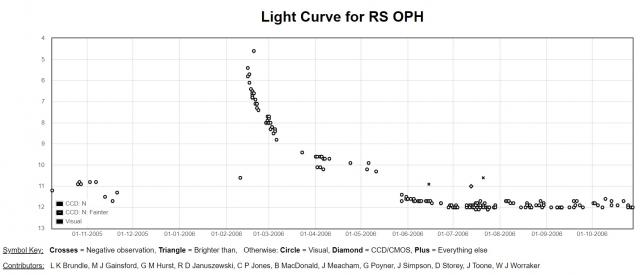 9 August 2021 at 10:33 am #584578
9 August 2021 at 10:33 am #584578 Dr Paul LeylandParticipant
Dr Paul LeylandParticipantI measured it at V=11.016 ± 0.005 at JD 2459431.4507
It’s been cloudy ever since. Unusual in these parts for this time of year.
Perhaps tonight …
9 August 2021 at 10:37 am #584579 Robin LeadbeaterParticipant
Robin LeadbeaterParticipantA series of spectra from 2006 taken using a Star Analyser.
http://www.threehillsobservatory.co.uk/astro/spectra_24.htm
I expect there will be many more spectra this time
Cheers
Robin
9 August 2021 at 1:07 pm #584580 Ernesto GuidoParticipantWe performed some follow-up of RS OPHIUCHI 2021 outburst through a TEL 0.1-m f/3.6 astrograph + CCD located in the Heaven’s Mirror Observatory, Australia (MPC code Q56) and operated by Telescope Live network.
Ernesto GuidoParticipantWe performed some follow-up of RS OPHIUCHI 2021 outburst through a TEL 0.1-m f/3.6 astrograph + CCD located in the Heaven’s Mirror Observatory, Australia (MPC code Q56) and operated by Telescope Live network.On images taken on August 09.42, 2020 we can confirm the presence of an optical counterpart (approximate R-filtered magnitude about +4.8; images were saturated in 10-second exposures) at coordinates:
R.A. = 17 50 13.20, Decl.= -06 42 28.2
(equinox 2000.0; UCAC4 catalogue reference stars for the astrometry).
Our image is available here: https://tinyurl.com/rsoph2021 or below
With kind regards,Ernesto Guido, Marco Rocchetto & Adriano Valvasori9 August 2021 at 3:22 pm #584581 Martin MobberleyParticipant
Martin MobberleyParticipantI’ve uploaded an image taken 1 hour ago to my community pages:
https://britastro.org/observations/observation.php?id=20210809_141707_eb50ae4fce13ebe3
Regards,
Martin
9 August 2021 at 5:14 pm #584582 Jeremy ShearsParticipant
Jeremy ShearsParticipantAtel 14838 from a team at Kyoto U report low resolution of RS Oph showing “Fe II, O I, and prominent Balmer lines. All of them listed here have a P Cygni profile. The velocity of the Hβ emission line is ∼ 2600 km/s. The profile and velocity indicate that this outburst is indeed a nova eruption, as is expected.”
10 August 2021 at 12:33 am #584586 David BoydParticipant
David BoydParticipantHere is a spectrum of RS Oph in outburst taken tonight, 9th August, with a LISA. Very sharply peaked H-alpha line with FWZI of about 7000 km/s. Other Balmer lines similarly broad, all with P Cygni absorption dips. I don’t remember seeing a spectrum quite like this before!
David
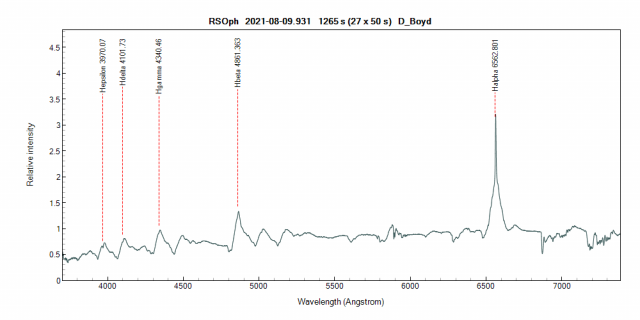 10 August 2021 at 11:57 am #584590
10 August 2021 at 11:57 am #584590 Daryl DobbsParticipant
Daryl DobbsParticipantVisible without binoculars but only just through the light pollution from Newport and Cardiff. Patchy cloud and nova was going behind trees when a patch cleared sufficiently for me to get an observation in. Then I had to balance on top of a wall holding my 20×80’s, our elderly neighbour seemed surprised! After 5 years living here she hasn’t got used to an amateur astronomer living next door. I’ll upload to database later.
Nice to see another bright Nova appear
10 August 2021 at 3:07 pm #584589 Robin LeadbeaterParticipant
Robin LeadbeaterParticipantThis is only the start! (The narrow unshifted feature comes from the circumsystem material from previous outbursts). If it follows earlier outburst there is lots more strangeness to come. Watch for highly ionised coronal lines (like [Fe X, XI, XIV] and [A X] etc) produced as the shock heats the gas to 1 million K plus. There is an interesting account of taking spectra early in the 1958 outburst by George Wallerstein in the 2005 S&T article.
Robin
10 August 2021 at 3:36 pm #584591 Robin LeadbeaterParticipant
Robin LeadbeaterParticipant“The narrow unshifted feature comes from the circumsystem material from previous outbursts”
Correction that should be ….from interaction with the relatively slow moving red giant wind. This looks a good reference for the evolution of the optical spectrum in the 2006 outburst
https://academic.oup.com/mnras/article/474/3/4211/4768437
Robin
11 August 2021 at 8:34 am #584593 Hugh AllenParticipant
Hugh AllenParticipantAmazing to have a hat trick of bright novae, and the latest such an anticipated event. The weather here in Somerset has been poor this last few weeks but in murky conditions I was able to capture RS Oph last night, just 20 minutes after Robin’s spectrum in the BAA spectroscopy database. There is good agreement between our two spectra, both captured with an Alpy 600. Compared to David’s spectrum from the previous night (higher resolution LISA spectrum), there has been a significant increase in the relative intensity of the emission lines but is this due mostly to a decline in brightness of the nova?
Cheers
Hugh
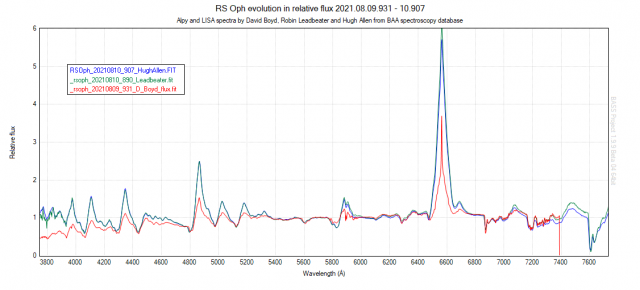 11 August 2021 at 11:26 am #584594
11 August 2021 at 11:26 am #584594 Robin LeadbeaterParticipant
Robin LeadbeaterParticipantThere is an absolutely stunning high resolution echelle spectrum covering 3750-9300A in the BAA database from Joan Guarro Flo taken 20210809.838 using an amateur designed (by Tim Lester) home built remotely operated instrument. (zoom in to view the narrow P Cygni lines from the stellar wind superimposed on the broad nova ejecta lines) An impressive example of the progress in amateur spectroscopy since the last outburst.
Cheers
Robin
11 August 2021 at 2:12 pm #584595 Dr Paul LeylandParticipant
Dr Paul LeylandParticipantThat is very impressive! I also love how the vibrational structure of the telluric molecular bands is so well resolved.
11 August 2021 at 6:53 pm #584596 Philip MasdingParticipant
Philip MasdingParticipantA nice clear evening came along just at the right time much to my surprise. Some fascinating links and images on this page. Thanks to all
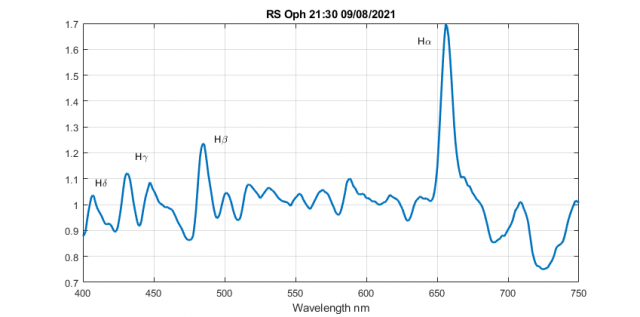 11 August 2021 at 7:13 pm #584597
11 August 2021 at 7:13 pm #584597 Jeremy ShearsParticipant
Jeremy ShearsParticipantStill bright, but on the turn. Do try and observe if you can.
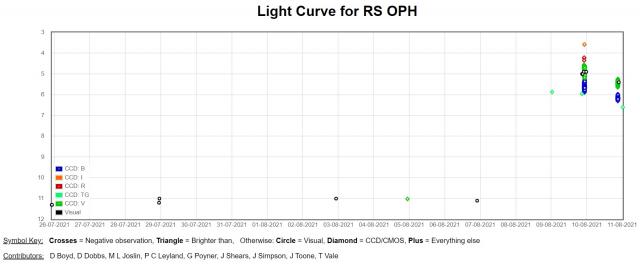 12 August 2021 at 8:58 am #584599
12 August 2021 at 8:58 am #584599 Alun HalseyParticipant
Alun HalseyParticipantHere is my attempt at RS Oph on the night of the 10th using my C9.25 and Lhires III (23 micron slit) to collect nine 60 second images,chose Vega as my reference star.
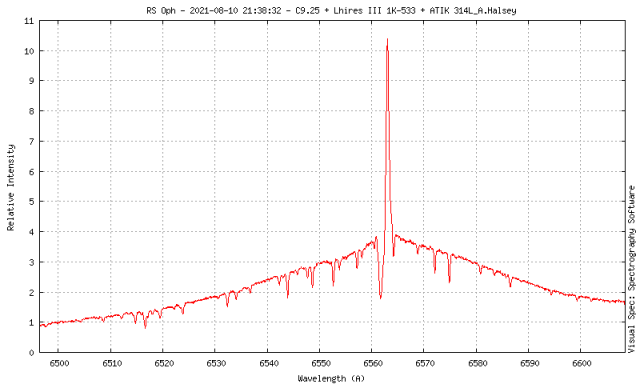
Alun
12 August 2021 at 10:59 am #584600 Paul G. AbelParticipant
Paul G. AbelParticipantIt looks like we may FINALLY get some clear skies here tonight- looking forward to making a magnitude estimate of it!
13 August 2021 at 9:22 am #584601 Alun HalseyParticipant
Alun HalseyParticipantAcquired another spectrum last night (12th) using Lhires III and C9.25. Acquisition time of 21 minutes (7x180sec) with 23 micron slit.
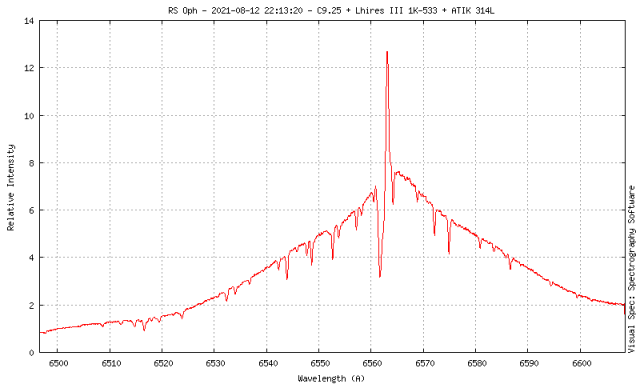
Alun
13 August 2021 at 1:31 pm #584602 David BoydParticipant
David BoydParticipantThe continuum flux level of the spectrum is dropping as the magnitude fades, V=4.88, 5.44, 6.24 for the 3 spectra below.
In answer to Hugh’s question above about the changes which have been taking place in the Balmer emission lines, I have posted information about this on the ARAS Forum at
http://www.spectro-aras.com/forum/viewtopic.php?f=36&t=2804&start=30#p15940
David
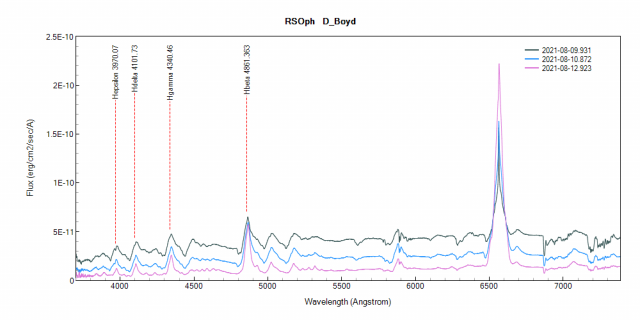
-
AuthorPosts
- You must be logged in to reply to this topic.

